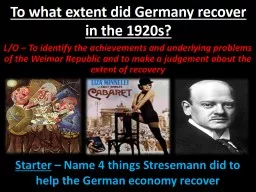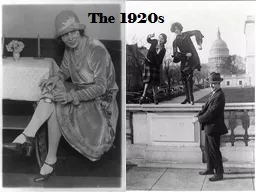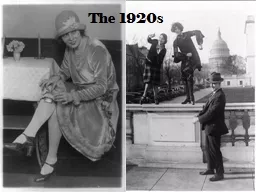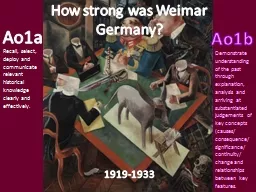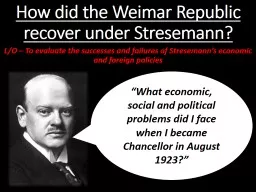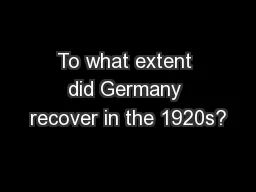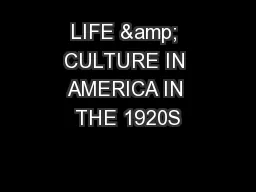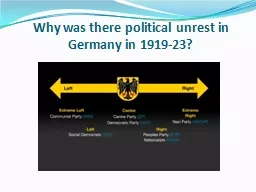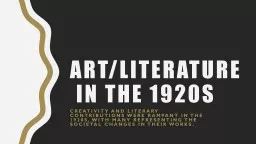PPT-To what extent did Germany recover in the 1920s?
Author : danika-pritchard | Published Date : 2017-04-20
LO To identify the achievements and underlying problems of the Weimar Republic and to make a judgement about the extent of recovery Starter Name 4 things Stresemann
Presentation Embed Code
Download Presentation
Download Presentation The PPT/PDF document "To what extent did Germany recover in th..." is the property of its rightful owner. Permission is granted to download and print the materials on this website for personal, non-commercial use only, and to display it on your personal computer provided you do not modify the materials and that you retain all copyright notices contained in the materials. By downloading content from our website, you accept the terms of this agreement.
To what extent did Germany recover in the 1920s?: Transcript
LO To identify the achievements and underlying problems of the Weimar Republic and to make a judgement about the extent of recovery Starter Name 4 things Stresemann did to help the German economy recover. The Roaring Twenties. Life Magazine cover page celebrating the 1920s, http://theroaringtwentieshistory.blogspot.ca/p/events-of-twenties.html . The Roaring Twenties. Music. Jazz, fast, happy, fun. Fashion. The 19th Amendment. Several states granted women suffrage in late 19th and early 20th centuries. Constitutional amendment proposed in 1918. Ratified in 1920. Guarantees the right to vote regardless of gender. Section 1. America Struggles . with Postwar Issues. Nativism. Came out of various worries following WWI. Prejudice against foreign-born people. Evident in immigration quotas, rise of the . Ku Klux Klan. 1919-1933. Ao1a. Ao1b. Recall, select, deploy and communicate relevant historical knowledge clearly and effectively.. Demonstrate understanding of the past through explanation, analysis and arriving at substantiated judgements of key concepts (causes/ consequence/ significance/ continuity/ change and relationships between key features.. L/O – To evaluate the successes and failures of Stresemann’s economic and foreign policies. “What economic, social and political problems did I face when I became Chancellor in August 1923?”. L/O – To identify the achievements and underlying problems of the Weimar Republic and to make a judgement about the extent of recovery. Starter. – Name 4 things Stresemann did to help the German economy recover. THE ROARING TWENTIES. Americans on the Move. Urbanization still accelerating.. More Americans lived in cities than in rural areas. 1920:. New York 5 million. Chicago 3 million. URBAN VS. RURAL. Farms started to struggle post-WWI.. Regionalism (Benton). Modernism (Stella, O’Keefe). Edward Hopper. Chop . Suey. (1929). Edward . Hopper was an American artist in the 1920s. Two common characteristics in his work show facets of American life, such as gas stations and theaters, and seascapes and rural landscapes. Because feminism was strong in the 1920s, many of his solitary figures are women.. . Roaring Twenties: . American Values. I will…. Compare. . The Simpsons . to Prohibition. We will…. (5A) evaluate . the impact of the 18. th. Amendment. (6A) analyze . the causes and effects of immigration, Social Darwinism, eugenics, race relations, nativism, the Red Scare, Prohibition, and the changing role of women. Before this time it was called the “dead ball era” and after the 1920s people have called it the “live ball era”. The game started getting popular rapidly. . There were lots of changes to the game in this time period. (structural and Cultural) . Learning objective . – to be able to understand why there was so much political unrest in Germany.. I can . describe. the reasons why there was so much political unrest in Germany between 1919 and 1923.. La gamme de thé MORPHEE vise toute générations recherchant le sommeil paisible tant désiré et non procuré par tout types de médicaments. Essentiellement composé de feuille de morphine, ce thé vous assurera d’un rétablissement digne d’un voyage sur . Creativity and literary contributions were rampant in the 1920s, with many representing the societal changes in their works.. Print Media. With more leisure time, and greater access to education, more people started to read during the 1920s. Reading books, magazines, and even other circulations became popular as a pastime. At the same time, more creative thinkers entered the scene to create to meets the demands.. ! . If you have to ask you probably already know…. BW – Write down everything you remember about the end of WWI. CW 1 – Practicing “Quick notes” WWI Review. CW 2 – notes on “Revolutionary” changes .
Download Document
Here is the link to download the presentation.
"To what extent did Germany recover in the 1920s?"The content belongs to its owner. You may download and print it for personal use, without modification, and keep all copyright notices. By downloading, you agree to these terms.
Related Documents

